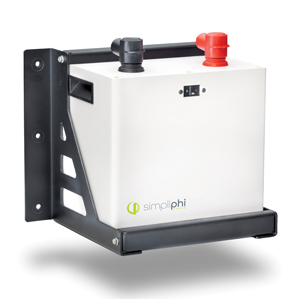Home Energy Storage Enters a New Era
Driven by the explosion of residential solar power, the market for home energy storage—which attracted little interest until earlier this year, when Tesla announced its Powerwall battery—is suddenly looking crowded.

This week at the Solar Power International show, in Anaheim, a company called SimpliPhi Power is unveiling a lightweight battery system for homes and small businesses that offers a longer life span than other lithium-ion batteries and doesn’t require expensive cooling and ventilation systems.
SimpliPhi’s bid comes a few weeks after another energy storage provider, Orison, released its design for a small plug-and-play battery system that, unlike the SimpliPhi and Powerwall options, does not require elaborate installation or permits for a home or small commercial setting.
Orison is not actually selling its products yet; the company plans to launch a Kickstarter campaign to take pre-orders and expects to begin selling in early 2016. Its innovations center on the batteries’ controls and communication systems: simply plugged into a wall socket, the battery enables a bidirectional flow of electricity, charging itself when power is flowing and sending power into the home circuits when it is not.
The growing popularity of residential solar panels is increasing interest in batteries that could store electricity from those installations. In the future, such storage systems could benefit homeowners, by giving them more control over how and when they obtain the power they need, while helping utilities by shifting demand to off-peak hours and smoothing out the load on the system.

For the moment, despite Tesla’s splashy entry into the market, such batteries still generally remain too expensive and cumbersome for most consumers. SolarCity, the largest solar provider in the United States, began offering a combined solar and storage system using Powerwall this summer, but it’s available only in newly built homes for now. And earlier this year rival SunEdison acquired Solar Grid Storage, an integrator of solar arrays and energy storage—but it’s not yet clear exactly what that will mean for the market in home energy storage.
The ultimate goal, for some users, will be to cut the cord completely: to install enough solar capacity and enough storage to get off the grid. But for most that won’t happen soon. “The market as we see is where people are still tied to the grid, but with distributed generation and storage, the grid becomes the backup,” says SimpliPhi CEO Catherine Von Burg.
Orison’s products will use a lithium manganese cobalt battery from a supplier that CEO Eric Clifton declines to name. SimpliPhi, on the other hand, is using a relatively new battery chemistry known as lithium iron phosphate. The absence of cobalt in the cathode makes lithium iron phosphate batteries less subject to material shortages (cobalt is scarce and expensive) and, more important, less prone to heating up—a problem with lithium-ion batteries, which have shown an alarming tendency to go into thermal runaway (uncontrolled heating that can destroy the battery) or even catch fire.
Lithium iron phosphate batteries are in use in a number of applications—BAE Systems, for instance, makes hybrid buses that use the technology—but have not been widely applied to distributed, stationary energy storage until now. SimpliPhi’s technology is based on chemistries orginally developed by battery pioneer John Goodenough.
The downside of lithium iron phosphate batteries is that they offer much less volumetric capacity than other lithium-ion chemistries—about 50 percent less than lithium cobalt oxide, for example, according to energy storage scientist Stanley Whittingham, director of the Institute for Materials Research at Binghamton University. “If you’ve got a garage to put it in, it’s fine,” Whittingham says. “It’ll take over wherever volume is not an issue.”
The Orison systems will start at around $1,600 for two kilowatt-hours of power (the average American home uses about 30 kilowatt-hours of electricity a day). The Powerwall starts at $3,000 for seven kilowatt-hours. That’s enough to keep the lights on for several hours, but not to run your home on all day. SimpliPhi has not yet released prices for its home systems. For the moment, whether homeowners and small-business owners will pay thousands of dollars for energy storage remains an open question.
Keep Reading
Most Popular
Large language models can do jaw-dropping things. But nobody knows exactly why.
And that's a problem. Figuring it out is one of the biggest scientific puzzles of our time and a crucial step towards controlling more powerful future models.
How scientists traced a mysterious covid case back to six toilets
When wastewater surveillance turns into a hunt for a single infected individual, the ethics get tricky.
The problem with plug-in hybrids? Their drivers.
Plug-in hybrids are often sold as a transition to EVs, but new data from Europe shows we’re still underestimating the emissions they produce.
Stay connected
Get the latest updates from
MIT Technology Review
Discover special offers, top stories, upcoming events, and more.